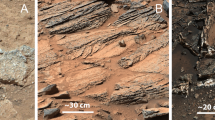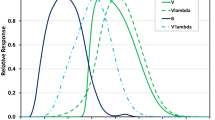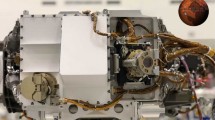Abstract
Direct imaging of the magnetosphere by the IMAGE spacecraft will be supplemented by observation of the global aurora, the footprint of magnetospheric regions. To assure the simultaneity of these observations and the measurement of the magnetospheric background neutral gas density, the IMAGE satellite instrument complement includes three Far Ultraviolet (FUV) instruments. In the wavelength region 120-190 nm, a downward-viewing auroral imager is only minimally contaminated by sunlight, scattered from clouds and ground, and radiance of the aurora observed in a nadir viewing geometry can be observed in the presence of the high-latitude dayglow. The Wideband Imaging Camera (WIC) will provide broad band ultraviolet images of the aurora for maximum spatial and temporal resolution by imaging the LBH N2 bands of the aurora. The Spectrographic Imager (SI), a monochromatic imager, will image different types of aurora, filtered by wavelength. By measuring the Doppler-shifted Ly-α, the proton-induced component of the aurora will be imaged separately. Finally, the GEO instrument will observe the distribution of the geocoronal emission, which is a measure of the neutral background density source for charge exchange in the magnetosphere. The FUV instrument complement looks radially outward from the rotating IMAGE satellite and, therefore, it spends only a short time observing the aurora and the Earth during each spin. Detailed descriptions of the WIC, SI, GEO, and their individual performance validations are discussed in companion papers. This paper summarizes the system requirements and system design approach taken to satisfy the science requirements. One primary requirement is to maximize photon collection efficiency and use efficiently the short time available for exposures. The FUV auroral imagers WIC and SI both have wide fields of view and take data continuously as the auroral region proceeds through the field of view. To minimize data volume, multiple images are taken and electronically co-added by suitably shifting each image to compensate for the spacecraft rotation. In order to minimize resolution loss, the images have to be distortion-corrected in real time for both WIC and SI prior to co-adding. The distortion correction is accomplished using high speed look up tables that are pre-generated by least square fitting to polynomial functions by the on-orbit processor. The instruments were calibrated individually while on stationery platforms, mostly in vacuum chambers as described in the companion papers. Extensive ground-based testing was performed with visible and near UV simulators mounted on a rotating platform to estimate their on-orbit performance. The predicted instrument system performance is summarized and some of the preliminary data formats are shown.
Similar content being viewed by others
References
Ajello, J. M.: 1990, ‘Solar Minimum Lyman-α Sky Background Observations from Pioneer Venus Orbiter Ultraviolet Spectrometer: Solar Wind Latitude Variation’, J. Geophys. Res. 95, 14855–14861.
Anger, C. D., Babey, S. K., Broadfoot, A. Lyle, Brown, R. G., Cogger, L. L., Gattinger, R., Haslett, J. W., King, R. A., McEwen, D. J., Murphree, J. S., Richardson, E. H., Sandel, B. R., Smith, K. and Jones, A. V.: 1987, ‘An Ultraviolet Auroral Imager for the Viking Spacecraft’, Geophys. Res. Lett. 14, 387.
Bishop, J.: 1999, ‘Transport of Resonant Atomic Hydrogen Emissions in the Thermosphere and Geocorona: Model Description and Applications’, J. Quant. Spectrosc. Radiat. Transfer 61, 473.
Coroniti, F. V. and Kennel, C. F.: 1972, ‘Changes in Magnetospheric Configuration During the Substorm Growth Phase’, J. Geophys. Res. 19, 3361.
Drob, D. P., Meier, B. R., Picone, J. M., Strickland, D. J., Cox, R. J. and Nicholas, A. C.: 1999, ‘Atomic Oxygen in the Thermosphere During the July 13, 1982, Solar Proton Event Deduced from Far Ultraviolet Images’, J. Geophys. Res. 104, 4267.
Frank, L. A., Craven, J. D., Ackerson, K. L., English, M. R., Eather, R. H. and Crovillano, R. L.: 1981, ‘Global Auroral Imaging Instrumentation for the Dynamics Explorer Mission’, Space Sci. Instrum. 5, 369–393.
Frank, L. A. and Craven, J. D.: 1988, ‘Imaging Results from Dynamics Explorer 1’, Rev. Geophys. 2, 249.
Frank, L. A. and Sigwarth, J. B.: 1999, ‘Atmospheric Holes: Instrumental and Geophysical Effects’, J. Geophys. Res. 104, 115.
Fuselier, S. A., Klumpar, D. M. and Shelley, E. G.: 1991, ‘Ion Reflection and Transmission During Reconnection at the Earth's Subsolar Magnetopause’, Geophys. Res. Lett. 18, 139.
Gladstone, G. R.: 1994, ‘Simulations of DE-1 UV Airglow Images’, J. Geophys. Res. 99, 11,441.
Hodges, R. R.: 1994, ‘Monte Carlo Simulation of the Terrestrial Hydrogen Exosphere’, J. Geophys. Res. 99, 23,229.
Hunten, D. M., Roach, F. E. and Chamberlain, J. W.: 1956, ‘A Photometric Unit for the Airglow and Aurora’, J. Atmos. Terr. Phys. 8, 345–346.
Immel, T. J., Craven, J. D. and Frank, L. A.: 1997, ‘Influence of IMF By on Large-Scale Decreases of O Column Density at Middle Latitudes’, J. Atmos. Terr. Phys. 59, 725.
Jorgensen, A. M., Spence, H. E., Henderson, M. G., Reeves, G. D., Sugiura, M. and Kamei, T.: 1997, ‘Global Energetic Neutral Atom (ENA) Measurements and Their Association with the Dst Index’, Geophys. Res.. Lett. 24, 3173–3176.
Lockwood, M., Chandler, M. O., Horowitz, J. L., Waite, J. H., Jr., Moore, T. E. and Chappell, C. R.: 1985, ‘The Cleft Ion Foundation’, J. Geophys. Res. 90, 9736.
Lui, A. T. Y., Venkatesan, D. and Murphree, J. S.: 1989, ‘Auroral Bright Spots on the Dayside Oval’, J. Geophys. Res. 94, 5515.
Lui, A. T. Y., Williams, D. J., Roelof, E. C., McEntire, R. W. and Mitchell, D. G.: 1996, ‘First Composition Measurements of Energetic Neutral Atoms’, Geophys. Res. Lett. 23, 2641–2644.
Meier, R. R.: 1991, ‘Ultraviolet Spectroscopy and Remote Sensing of the Upper Atmosphere’, Space Sci. Rev. 58, 1.
Murphree, J. S., King, R. A., Payne, T., Smith, K., Reid, D., Adema, J., Gordon, B. and Wlochowicz, R.: 1994, ‘The Freja Ultraviolet Imager’, Space Sci. Rev. 70, 421–446.
Pollock, C. J., Chandler, M. O., Moore, T. E., Waite, J. H., Jr., Chappell, C. R. and Gurnett, D.: 1990, ‘A Survey of Upwelling Ion Event Characteristics’, J. Geophys. Res. 95, 18969.
Rairden, R. L., Frank, L. A. and Craven, J. D.: 1986, ‘Geocoronal Imaging with Dynamics Explorer’, J. Geophys. Res. 91, 13,613.
Roelof, E. C.: 1987, ‘Energetic Neutral Atom Image of the Storm Time Ring Current’, Geophys. Res. Lett. 14, 652.
Roelof, E. C., Mitchell, D. G. and Williams, D. J.: 1985, ‘Energetic Neutral Atoms (E ~ 50 keV) from the Ring Current: IMP 7/8 and ISEE 1’, J. Geophys. Res. 90, 10,991.
Strickland, D. J. and Anderson, D. E., Jr.: 1983, ‘Radiation Transport Effects on the OI 1356-AA Limb Intensity Profile in the Dayglow’, J. Geophys. Res. 88, 9260.
Strickland, D. J., Jasperse, J. P. and Whalen, J. A.: 1983, ‘Dependence of Auroral FUV Emissions on the Incident Electron Spectrum and Neutral Atmosphere’, J. Geophys. Res. 88, 8051–8062.
Strickland, D. J., Daniell, R. E., Jr., Jasperse, J. R. and Basu, B.: 1993, ‘Transport-Theoretic Model for the Electron-Proton-Hydrogen Atom Aurora’, J. Geophys. Res. 98, 21533.
Strickland, D. J., Evans, J. S. and Paxton, L. J.: 1995, ‘Satellite Remote Sensing of Thermospheric O/N2 and Solar EUV. 1. Theory’, J. Geophys. Res. 100, 12,217–122,26.
Strickland, D. J., Cox, R. J., Meier, R. R. and Drob, D. P.: 1999, ‘Global O/N2 Derived from DE-1 FUV Dayglow Data: Technique and Examples from Two Storm Periods’, J. Geophys. Res. 104, 4251.
Torr, M. R., Torr, D. G., Zukic, M., Johnson, R. B., Ajello, J., Banks, P., Clark, K., Cole, K., Keffer, C., Parks, G., Tsuratani, B. and Spann, J.: 1995, ‘A Far Ultraviolet Imager for the International Solar-Terrestrial Physics Mission’, Space Sci. Rev. 71, 329.
Williams, D. J., Roelof, E. C. and Mitchell, D. G.: 1992, ‘Global Magnetospheric Imaging’, Rev. Geophys. 30, 183–208.
Williams, D. J.: 1990, ‘Why We Need Global Observations’, in B. Hultquist and C. G. Fälthammer (eds), Magnetospheric Physics, Plenum, New York, pp. 83–101.
Author information
Authors and Affiliations
Rights and permissions
About this article
Cite this article
Mende, S., Heetderks, H., Frey, H. et al. Far ultraviolet imaging from the IMAGE spacecraft. 1. System design. Space Science Reviews 91, 243–270 (2000). https://doi.org/10.1023/A:1005271728567
Issue Date:
DOI: https://doi.org/10.1023/A:1005271728567




